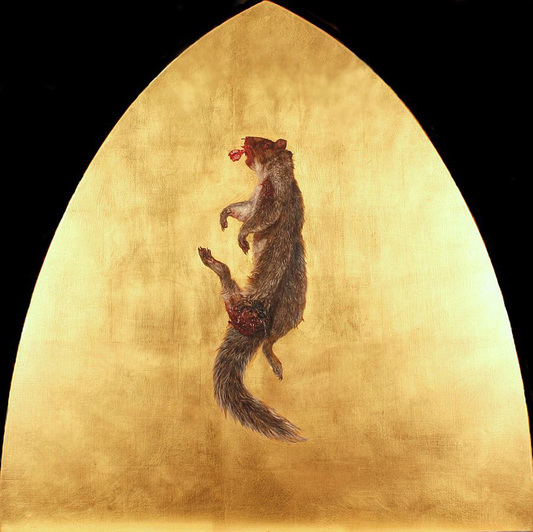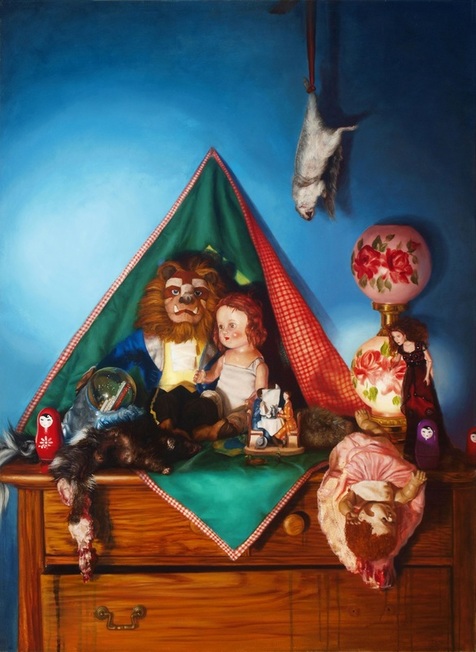INTERVIEW WITH CARA DeANGELIS
S&A: Thank you, Cara, for agreeing to discuss your work with S&A. Looking at your paintings in tandem with your artist statement brings up many relevant concerns about the current state of our natural world and its survival. The closing line of your artist statement is particularly salient: "These paintings also explore and question the role of wildlife in an increasingly industrialized society, and the place for them in what’s been now termed by some as a ‘Post-Natural Age’. Could you tell us about the events or decisions that led you to explore the role of wildlife in our modern world, consequently inspiring the roadkill series?
CD: The phrase “Post-Natural Age” was used by the American poet Gary Snyder (whose work I was introduced to by my friend, and fellow artist, Emily Davis Adams. Having grown up in a suburb outside of New York City, where people drive like New Yorkers but live with wildlife, the term struck me as incredibly relevant. Living in the reality of the “Post-Natural Age” affected me greatly both as a person and an artist.
There is a lot of roadkill in Connecticut, every year thousands of animals are hit. When I started driving a car I was shocked by the carnage I’d see, and it didn’t take me that long to feel like I needed to do something to help.
S&A: It’s my impression that your paintings do more than intellectualize a concern for wildlife, they also seem to have the power to rekindle a regard for animals/nature in the heart of the viewer who exists in the ‘Post-Natural Age’. This is not to say that the work is sentimental; quite the contrary, your work seems to hold an uncompromising mirror up to human actions. Woman with Roadkill IV depicts a modern couple in an intimate setting where they both appear to be preoccupied in thought or activity. Meanwhile, two deceased animals lie in front of the woman. What is the meaning and/or message behind this painting?
CD: All of the Woman with Roadkill paintings are first and foremost satirizing Aristocratic Portraiture throughout art history (those stuffy paintings of privileged women with lap-dogs on their knees). So, the paintings are meant to be somewhat humorous.The pathos comes in, as you mentioned, with the dead animals lying either on their laps or near them.That piece in particular took the idea of Aristocratic Portrait and molded it into a Genre Scene.There are references to famous stories dealing with human and animal interaction, like Leda and the Swan, as well as Disney references, which I’ve been using a lot lately.
CD: The phrase “Post-Natural Age” was used by the American poet Gary Snyder (whose work I was introduced to by my friend, and fellow artist, Emily Davis Adams. Having grown up in a suburb outside of New York City, where people drive like New Yorkers but live with wildlife, the term struck me as incredibly relevant. Living in the reality of the “Post-Natural Age” affected me greatly both as a person and an artist.
There is a lot of roadkill in Connecticut, every year thousands of animals are hit. When I started driving a car I was shocked by the carnage I’d see, and it didn’t take me that long to feel like I needed to do something to help.
S&A: It’s my impression that your paintings do more than intellectualize a concern for wildlife, they also seem to have the power to rekindle a regard for animals/nature in the heart of the viewer who exists in the ‘Post-Natural Age’. This is not to say that the work is sentimental; quite the contrary, your work seems to hold an uncompromising mirror up to human actions. Woman with Roadkill IV depicts a modern couple in an intimate setting where they both appear to be preoccupied in thought or activity. Meanwhile, two deceased animals lie in front of the woman. What is the meaning and/or message behind this painting?
CD: All of the Woman with Roadkill paintings are first and foremost satirizing Aristocratic Portraiture throughout art history (those stuffy paintings of privileged women with lap-dogs on their knees). So, the paintings are meant to be somewhat humorous.The pathos comes in, as you mentioned, with the dead animals lying either on their laps or near them.That piece in particular took the idea of Aristocratic Portrait and molded it into a Genre Scene.There are references to famous stories dealing with human and animal interaction, like Leda and the Swan, as well as Disney references, which I’ve been using a lot lately.
Woman with Roadkill IV. Oil on linen; 121.9 x 167.6 cm (48″ x 66″).
S&A: In Ascension IV, you used a variety of media, including gold leaf, to create the image of a squirrel who has been hit by a speeding vehicle. The squirrel, perhaps originally viewed from overhead, when placed vertically, is reminiscent of a holy figure ascending to heaven. The use of gold leaf, the sensitivity you employ in rendering its damaged body, and the Gothic arch add to the sacred impression of the work. Are you attempting to reintroduce a reverence for nature in Ascension IV? What inspired you to reference traditional European religious symbols?
CD: With the Ascensions I’m definitely quoting European altar-pieces and religious symbols. I was raised Russian Orthodox and there were prodigious amounts of gold-leaf, arches, and blood used in the altars and architecture of the church we went to. With these pieces I am offering reverence to these ascending corpses, while questioning the anthropocentric nature of organized religion.
CD: With the Ascensions I’m definitely quoting European altar-pieces and religious symbols. I was raised Russian Orthodox and there were prodigious amounts of gold-leaf, arches, and blood used in the altars and architecture of the church we went to. With these pieces I am offering reverence to these ascending corpses, while questioning the anthropocentric nature of organized religion.
Ascension IV. Oil, tar, asphalt, and gold leaf on wood; 68.5 x 68.5 cm (27″x 27″).
S&A: When readers visit your website they will discover more paintings from your roadkill series. Some of your paintings juxtapose stuffed animals with roadkill. This juxtaposition is interesting on multiple levels, to mention one, the realization that both are equally inanimate but the asymmetry of our personal attachment is palpable. What interplay of meaning did you intend between the copy of the animal and the real animal? Could you tell us more about how toys are to be understood as an analogue to ‘nostalgia’ and the ‘infantile’?
CD: The toys and dolls represent the beginning of life. In this sense they are the “Infantile,” while the adult viewer will see them as “Nostalgia.” On the other hand, the roadkill clearly represents the end of life. By putting them together you get the full circle, presenting a stark comparison between the synthetically manufactured and dyed “fur” of the stuffed animal and the organic and intricately patterned fur of the real one. Both are beautiful, and both speak of our complex relationship with animals and with wildlife. But, when one is dead and the other is faking its existence, it does make a sort of twisted and depressing correlation.
I also use the toys to bring some levity to the series, so that it’s not just depressing. In this sense, they change the mood of the paintings dramatically.
CD: The toys and dolls represent the beginning of life. In this sense they are the “Infantile,” while the adult viewer will see them as “Nostalgia.” On the other hand, the roadkill clearly represents the end of life. By putting them together you get the full circle, presenting a stark comparison between the synthetically manufactured and dyed “fur” of the stuffed animal and the organic and intricately patterned fur of the real one. Both are beautiful, and both speak of our complex relationship with animals and with wildlife. But, when one is dead and the other is faking its existence, it does make a sort of twisted and depressing correlation.
I also use the toys to bring some levity to the series, so that it’s not just depressing. In this sense, they change the mood of the paintings dramatically.
Dolls and Roadkill II. Oil and tar on canvas; 132 x 96.6 cm (52″ x 38″).
S&A: Why is working in a representational manner suitable for the conveyance of your message and ideas?
CD: I love quoting art history, and pointing a finger at it through my paintings. I like when people notice “Oh, she’s quoting those Dutch Still Lifes!” When people get that reference, the painting’s deeper meaning becomes apparent, because they start to realize that the wildlife we once hunted for food or sport, that we once had a relationship with, are now killed anonymously by people in automobiles. They begin to think about the fact that these beautiful animals are left to rot in public.
This is also why it’s a good thing the paintings have some humor in them, because it’s not an easy subject. Being able to make some people laugh makes the subject matter more approachable. So the toys come in, or some mating flies, or something. Sure the viewer might cry, but hopefully they can laugh at some point too, and that will keep them thinking about it all afterward.
S&A: What direction will the roadkill series take in the near future?
CD: I’m working on more still lifes in a “grander” direction. I’ve also begun making roadside memorials for the actual animals when I’m done painting them. I bring them back approximately where I found them, and leave a little memorial for them for drivers to see as they pass by. Needless to say, the set ups don’t last very long before sanitation takes them (and the body) away, but I’m hoping to start creating so many of them that maybe they’ll just give up and let the animal be memorialized. I guess this goes back to the “Soul” issue again.
CD: I love quoting art history, and pointing a finger at it through my paintings. I like when people notice “Oh, she’s quoting those Dutch Still Lifes!” When people get that reference, the painting’s deeper meaning becomes apparent, because they start to realize that the wildlife we once hunted for food or sport, that we once had a relationship with, are now killed anonymously by people in automobiles. They begin to think about the fact that these beautiful animals are left to rot in public.
This is also why it’s a good thing the paintings have some humor in them, because it’s not an easy subject. Being able to make some people laugh makes the subject matter more approachable. So the toys come in, or some mating flies, or something. Sure the viewer might cry, but hopefully they can laugh at some point too, and that will keep them thinking about it all afterward.
S&A: What direction will the roadkill series take in the near future?
CD: I’m working on more still lifes in a “grander” direction. I’ve also begun making roadside memorials for the actual animals when I’m done painting them. I bring them back approximately where I found them, and leave a little memorial for them for drivers to see as they pass by. Needless to say, the set ups don’t last very long before sanitation takes them (and the body) away, but I’m hoping to start creating so many of them that maybe they’ll just give up and let the animal be memorialized. I guess this goes back to the “Soul” issue again.
To view more paintings by Cara DeAngelis, visit her website: www.caradeangelis.com


